This is an AI Free Zone: Text created by Large Language Models is spreading across the Internet. It's well-written, but frequently inaccurate. If you find a mistake on Spaceweather.com, rest assured it was made by a real human being. | | |
NO SOLAR FLARES TODAY: All five sunspots on the solar disk are stable and quiet. NOAA says the odds of an X-flare today are no more than 1%. The quiet is likely to persist for the next 3 days at least. Solar flare alerts: SMS Text.
GREAT GEMINIDS: The Geminid meteor shower peaked on Dec. 14th when Earth passed through a gravelly stream of debris from 'rock comet' 3200 Phaethon. "This year's shower ranks as the best I've ever seen," reports Dan Bush, who photographed a Moon-bright fireball from his backyard in Albany, Missouri:
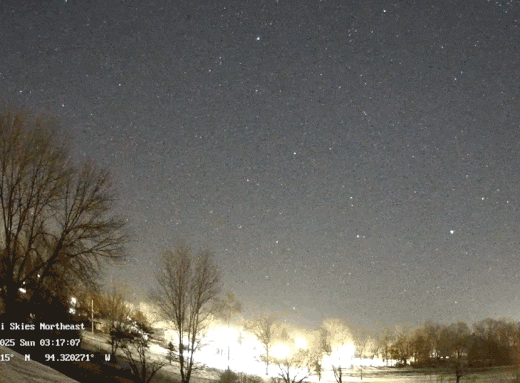
"It was incredible," says Bush. During the peak, observers reporting to the International Meteor Organization counted as many as 120 Geminids per hour-- a couple of meteors per minute under ideal skies. Meteor rates should decrease on Dec. 15th, but not to zero. Between 20 and 30 meteors per hour are possible tonight as the shower subsides. [sky map]
more images: from David Blanchard at Mormon Lake, AZ; from Greg Connor of Ridgecrest, CA; from Marcus Prazniak of Tonopah, NV; from Eliot Herman of Tucson, AZ; from Jan Curtis of Cheyenne, WY
DO YOU HAVE GEMINIDS ON YOUR ROOF? The question is not as crazy as it sounds. Researchers estimate that micrometeorites 0.1 mm wide fall about once a year per square meter. A typical rooftop therefore collects hundreds per year. In the Lofoten Islands of Norway, Rob Stammes thinks he may have recorded the pitter-patter of meteorites on his own roof. Listen to a sample impact, then scroll down for the full story.
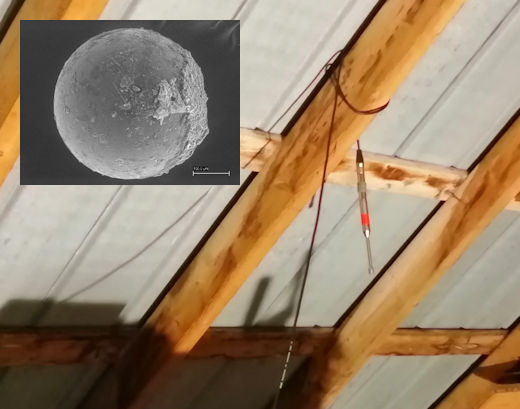
Above: The microphone under Rob Stammes' roof. Inset: A sample 0.4 mm micrometeorite collected from a rain gutter in Alabama.
"For years I have been listening with microphones on my roof for potential sounds during the Northern Lights," says Stammes, who is a respected citizen scientist with a space weather lab deep inside the Arctic Circle. "Occasionally, I noticed small stones rolling into the microphone on my roof."
"My roof, like many houses here, is made of thin steel sheeting. Its surface area is approximately 320 square meters. Under the roof, the space is mostly empty. I decided to mount a microphone there. It is an ideal place because there is no snow or wind, and the temperature is around zero. Again, I recorded rolling stones."
"Two weeks ago, I realized it might be coming from space," he says. "Looking in the Store Norske Leksikon, I read that micrometeorites of 0.1 mm fall about once a year per square meter. So, on my large roof, there's a good chance, and yes, I've had three audio observations in the past few nights, two of which were in the early hours of Dec. 12th."
"Perhaps this would be a fun experiment for others as well," says Stammes. "All you need is a condensor microphone, inline amplifier and a pro digital recorder." Just don't forget the metal roof.
Realtime Space Weather Photo Gallery
Free: Spaceweather.com Newsletter
10% OFF CHRISTMAS GIFTS TODAY: Christmas is coming. Are you looking for a far-out gift? Check out the Earth to Sky Store. It's filled with items that have visited the edge of space onboard cosmic ray research balloons:
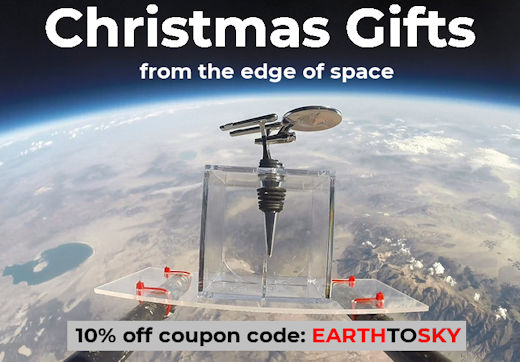
Earth to Sky gifts have flown above 99.7% of Earth's atmosphere, experiencing space-like blasts of cosmic rays, extreme cold, and a wild ride parachuting back to Earth after the balloon explodes. Even Amazon doesn't carry items this far out.
Don't forget to enter coupon code "EARTHTOSKY" at checkout for a 10% holiday discount.
Far Out Gifts: Earth to Sky Store
All sales support hands-on STEM education
Realtime Comet Photo Gallery
Free: Spaceweather.com Newsletter
Realtime Aurora Photo Gallery
Free: Spaceweather.com Newsletter
Every night, a network of
NASA all-sky cameras scans the skies above the United States for meteoritic fireballs. Automated software maintained by NASA's Meteoroid Environment Office calculates their orbits, velocity, penetration depth in Earth's atmosphere and many other characteristics. Daily results are presented here on Spaceweather.com.
On Dec. 15 2025, the network reported 27 fireballs.
(13 Geminids, 10 sporadics, 2 Hydrids, 1 Dec. Monocerotid, 1 Dec. Leonis Minorid)
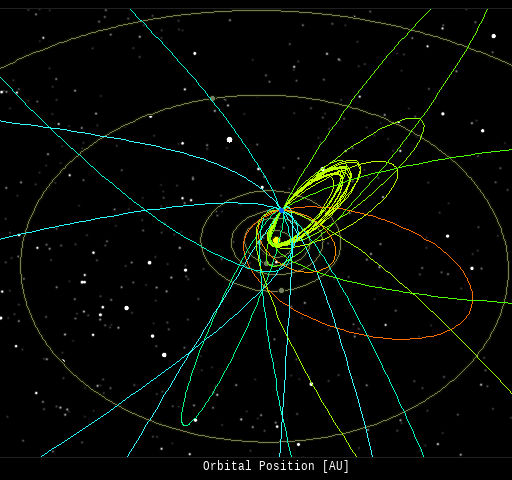
In this diagram of the inner solar system, all of the fireball orbits intersect at a single point--Earth. The orbits are color-coded by velocity, from slow (red) to fast (blue). [Larger image] [movies]
Potentially Hazardous Asteroids (
PHAs) are space rocks larger than approximately 100m that can come closer to Earth than 0.05 AU. None of the known PHAs is on a collision course with our planet, although astronomers are finding
new ones all the time.
On December 15, 2025 there were 2349 potentially hazardous asteroids.
 |
Recent & Upcoming Earth-asteroid encounters: | Asteroid | Date(UT) | Miss Distance | Velocity (km/s) | Diameter (m) |
| 2025 WK4 | 2025-Dec-10 | 8.9 LD | 5.5 | 32 |
| 2025 XP2 | 2025-Dec-10 | 7.5 LD | 4.6 | 10 |
| 2025 XH2 | 2025-Dec-10 | 9.3 LD | 8.3 | 23 |
| 2025 XL4 | 2025-Dec-10 | 0.8 LD | 9.8 | 3 |
| 2025 XL | 2025-Dec-10 | 6.1 LD | 14.4 | 30 |
| 2025 XB1 | 2025-Dec-10 | 0.3 LD | 8.6 | 6 |
| 2025 XR1 | 2025-Dec-10 | 3.9 LD | 5.6 | 5 |
| 1999 SF10 | 2025-Dec-10 | 8.2 LD | 4.4 | 46 |
| 2025 XC2 | 2025-Dec-11 | 13.6 LD | 8.9 | 53 |
| 2025 XN3 | 2025-Dec-11 | 8.6 LD | 12.7 | 10 |
| 2019 XN3 | 2025-Dec-11 | 4.9 LD | 3.7 | 15 |
| 2025 XO4 | 2025-Dec-11 | 13.3 LD | 13.4 | 23 |
| 2025 XX3 | 2025-Dec-11 | 3.7 LD | 6.6 | 7 |
| 2025 XK1 | 2025-Dec-12 | 2.6 LD | 4.3 | 12 |
| 2025 XK4 | 2025-Dec-12 | 5.6 LD | 9.9 | 11 |
| 2025 XA3 | 2025-Dec-12 | 3.6 LD | 6 | 11 |
| 2025 XZ3 | 2025-Dec-12 | 0.4 LD | 9.2 | 6 |
| 2025 WH20 | 2025-Dec-12 | 10.9 LD | 8.9 | 27 |
| 2025 XG2 | 2025-Dec-12 | 3.9 LD | 8.3 | 16 |
| 2025 XF2 | 2025-Dec-12 | 1.3 LD | 6.9 | 6 |
| 2025 XF1 | 2025-Dec-13 | 0.8 LD | 3.6 | 9 |
| 2025 WY9 | 2025-Dec-13 | 14.5 LD | 5.3 | 17 |
| 2025 XZ4 | 2025-Dec-13 | 0.9 LD | 20.2 | 11 |
| 2025 XS3 | 2025-Dec-14 | 1.5 LD | 9.2 | 3 |
| 2025 XW3 | 2025-Dec-14 | 0.5 LD | 9 | 5 |
| 2025 XW2 | 2025-Dec-14 | 5.8 LD | 17.6 | 28 |
| 2025 TZ | 2025-Dec-15 | 17.8 LD | 6.2 | 53 |
| 2025 WA14 | 2025-Dec-15 | 20 LD | 9.3 | 34 |
| 2025 XX2 | 2025-Dec-15 | 2.4 LD | 8.2 | 11 |
| 2016 YH | 2025-Dec-15 | 7.6 LD | 8.8 | 28 |
| 2025 WA3 | 2025-Dec-15 | 8.9 LD | 19.4 | 259 |
| 2025 XN4 | 2025-Dec-16 | 0.5 LD | 14.8 | 12 |
| 2025 XP4 | 2025-Dec-17 | 14 LD | 8 | 31 |
| 2025 XJ2 | 2025-Dec-17 | 5.7 LD | 11.9 | 20 |
| 2025 WD4 | 2025-Dec-17 | 19.9 LD | 12.7 | 45 |
| 2025 WN6 | 2025-Dec-17 | 15.9 LD | 2.9 | 37 |
| 2025 XV | 2025-Dec-18 | 6.8 LD | 9.5 | 97 |
| 2015 XX168 | 2025-Dec-18 | 6 LD | 11.4 | 27 |
| 2025 XV3 | 2025-Dec-19 | 14.7 LD | 15 | 54 |
| 2025 XQ3 | 2025-Dec-19 | 9 LD | 15.1 | 33 |
| 2025 XV1 | 2025-Dec-20 | 16.9 LD | 7.8 | 23 |
| 2010 WR7 | 2025-Dec-20 | 19.4 LD | 8.3 | 71 |
| 2025 XT4 | 2025-Dec-20 | 6.6 LD | 6 | 9 |
| 2025 XC4 | 2025-Dec-20 | 14.5 LD | 9.6 | 22 |
| 2025 XX4 | 2025-Dec-20 | 16.7 LD | 5.9 | 25 |
| 2025 WT3 | 2025-Dec-22 | 16 LD | 4.5 | 25 |
| 2025 XP3 | 2025-Dec-26 | 13.4 LD | 13.5 | 56 |
| 2025 XJ4 | 2025-Dec-27 | 14.4 LD | 6.7 | 36 |
| 2021 AB1 | 2025-Dec-28 | 10.2 LD | 12.3 | 16 |
| 2019 AU | 2025-Dec-30 | 19.3 LD | 2.8 | 16 |
| 2024 AV2 | 2025-Dec-30 | 17.9 LD | 7 | 17 |
| 2014 AF16 | 2026-Jan-04 | 9 LD | 9.6 | 34 |
| 2025 XS4 | 2026-Jan-06 | 8 LD | 6.5 | 24 |
| 2023 XM15 | 2026-Jan-07 | 15.2 LD | 6.9 | 51 |
| 2022 GR3 | 2026-Jan-12 | 14.5 LD | 12.9 | 9 |
| 2025 XN1 | 2026-Jan-14 | 9.2 LD | 4.7 | 35 |
| 2022 OB5 | 2026-Jan-14 | 1.7 LD | 2.2 | 6 |
| 2025 BL | 2026-Jan-17 | 4.7 LD | 6.9 | 28 |
| 2004 MO3 | 2026-Jan-17 | 17 LD | 10.2 | 129 |
| 2011 AM37 | 2026-Jan-17 | 19.8 LD | 5.1 | 4 |
| 2019 LZ4 | 2026-Jan-23 | 14.2 LD | 11.6 | 45 |
| 2022 AG | 2026-Jan-29 | 13.7 LD | 5.3 | 34 |
| 2020 GE | 2026-Jan-29 | 16.2 LD | 1.2 | 8 |
| 2023 RX1 | 2026-Jan-31 | 8.8 LD | 1.2 | 3 |
| 2022 OC3 | 2026-Jan-31 | 1.3 LD | 3.8 | 8 |
| 2021 CZ5 | 2026-Feb-09 | 18.3 LD | 9.3 | 23 |
| 2025 CC | 2026-Feb-09 | 17.6 LD | 5.1 | 11 |
| 2019 CN2 | 2026-Feb-11 | 20 LD | 9.2 | 7 |
| 2022 DV | 2026-Feb-12 | 15.4 LD | 5 | 18 |
Notes: LD means "Lunar Distance." 1 LD = 384,401 km, the distance between Earth and the Moon. 1 LD also equals 0.00256 AU. | | Cosmic Rays in the Atmosphere |
SPACE WEATHER BALLOON DATA: Almost once a week, Spaceweather.com and the students of Earth to Sky Calculus fly space weather balloons to the stratosphere over California. These balloons are equipped with sensors that detect secondary cosmic rays, a form of radiation from space that can penetrate all the way down to Earth's surface. Our monitoring program has been underway without interruption for 10 years, resulting in a unique dataset of in situ atmospheric measurements.
Latest results (Nov. 2024): Atmospheric radiation is sharply decreasing in 2024. Our latest measurements in November registered a 10-year low:
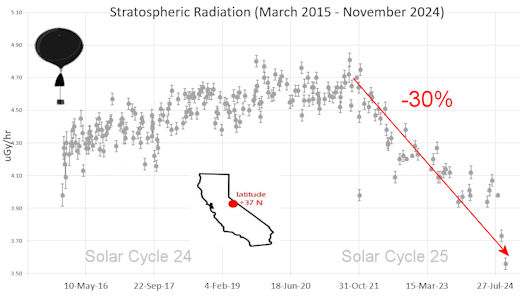
What's going on? Ironically, the radiation drop is caused by increasing solar activity. Solar Cycle 25 has roared to life faster than forecasters expected. The sun's strengthening and increasingly tangled magnetic field repels cosmic rays from deep space. In addition, solar coronal mass ejections (CMEs) sweep aside cosmic rays, causing sharp reductions called "Forbush Decreases." The two effects blend together to bring daily radiation levels down.
.Who cares? Cosmic rays are a surprisingly "down to Earth" form of space weather. They can alter the chemistry of the atmosphere, trigger lightning, and penetrate commercial airplanes. According to a study from the Harvard T.H. Chan school of public health, crews of aircraft have higher rates of cancer than the general population. The researchers listed cosmic rays, irregular sleep habits, and chemical contaminants as leading risk factors. A number of controversial studies (#1, #2, #3, #4) go even further, linking cosmic rays with cardiac arrhythmias and sudden cardiac death.
Technical notes: The radiation sensors onboard our helium balloons detect X-rays and gamma-rays in the energy range 10 keV to 20 MeV. These energies span the range of medical X-ray machines and airport security scanners.
Data points in the graph labeled "Stratospheric Radiation" correspond to the peak of the Regener-Pfotzer maximum, which lies about 67,000 feet above central California. When cosmic rays crash into Earth's atmosphere, they produce a spray of secondary particles that is most intense at the entrance to the stratosphere. Physicists Eric Regener and Georg Pfotzer discovered the maximum using balloons in the 1930s and it is what we are measuring today.
| | The official U.S. government space weather bureau |
| | The first place to look for information about sundogs, pillars, rainbows and related phenomena. |
| | Researchers call it a "Hubble for the sun." SDO is the most advanced solar observatory ever. |
| | 3D views of the sun from NASA's Solar and Terrestrial Relations Observatory |
| | Realtime and archival images of the Sun from SOHO. |
| | information about sunspots based on the latest NOAA/USAF Active Region Summary |
| | current counts of failed and deployed Starlink satellites from Jonathan's Space Page. See also, all satellite statistics. |
| | Authoritative predictions of space junk and satellite re-entries |
| | from the NOAA Space Environment Center |
| | fun to read, but should be taken with a grain of salt! Forecasts looking ahead more than a few days are often wrong. |
| | from the NOAA Space Environment Center |
| | the underlying science of space weather |
 | Got a chipped or cracked windshield that prevents you from seeing space weather events while driving? Get windshield replacement from SR Windows & Glass with free mobile auto glass service anywhere in the Phoenix area. |
| | These links help Spaceweather.com stay online. Thank you to our supporters! |
| | | | | | |

